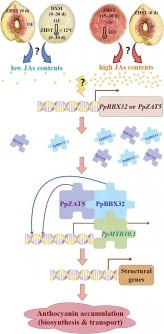
A recent study has identified the genetic mechanisms behind the color variations in peaches, revealing how specific genes interact with environmental factors to influence fruit pigmentation. Researchers from Zhejiang University and the New Zealand Institute for Plant & Food Research published their findings in the journal Horticulture Research on July 30, 2024. Their work sheds light on the roles of two genes, PpBBX32 and PpZAT5, in regulating the production of anthocyanins, the pigments responsible for the appealing red, purple, and blue hues found in many fruits and vegetables.
The research highlights that anthocyanin levels in peaches vary significantly depending on the cultivar, tissue type, and storage conditions. For instance, moderate cold storage can induce red coloring in the outer flesh of certain peach varieties, while others do not respond similarly. The study emphasizes the need to explore the upstream regulatory mechanisms of these genes, as the relationship between environmental influences and hormone signaling is not fully understood.
Using transcriptomic comparisons across different peach cultivars and storage scenarios, the researchers discovered that the accumulation of anthocyanins in the outer flesh of the ‘Zhonghuashoutao’ variety only occurred at a temperature of 16°C. They identified PpBBX32 and PpZAT5 as key regulators, noting their strong correlation with anthocyanin levels. Functional assays indicated that overexpressing these genes significantly increased pigment levels in both peaches and tobacco plants, while silencing them led to reduced anthocyanin accumulation.
The study revealed that PpBBX32 and PpZAT5 bind directly to the promoter of another gene, PpMYB10.1, activating its transcription. They also form a ternary protein complex—PpZAT5–PpBBX32–PpMYB10.1—that enhances the activation of genes associated with pigment production. Moreover, the expression of these genes was found to be inducible by methyl jasmonate, a plant hormone, and their activity correlated with anthocyanin levels across various tissues and temperatures.
Dr. Changjie Xu, the corresponding author of the study, noted, “This study gives us a molecular explanation for something growers and consumers have observed for years—why some peaches develop beautiful red flesh while others don’t.” By identifying PpBBX32 and PpZAT5 as central regulators responsive to temperature and hormonal signals, this research expands the understanding of fruit pigmentation. Additionally, it provides breeders with potential targets for enhancing the aesthetic and health attributes of peaches.
The implications of these findings extend beyond the realm of peach cultivation. The research offers practical opportunities for breeding programs, postharvest storage solutions, and hormonal treatments designed to enhance fruit coloration. By focusing on the PpBBX32–PpZAT5–PpMYB10.1 regulatory module, breeders may be able to develop peach cultivars with more vibrant and consistent red flesh, regardless of environmental conditions. Furthermore, applying jasmonate analogs or optimizing storage temperatures could help activate these genetic pathways in harvested fruit, boosting their anthocyanin content.
This innovative research not only benefits peach production but could also be applied to other crops where color is a vital quality trait, thus paving the way for advancements in horticultural science and food quality enhancement. The study was funded by the National Natural Science Foundation of China and other supporting organizations, highlighting the collaborative effort behind this significant research.
For further details, the complete study can be accessed through its DOI: 10.1093/hr/uhae212.






